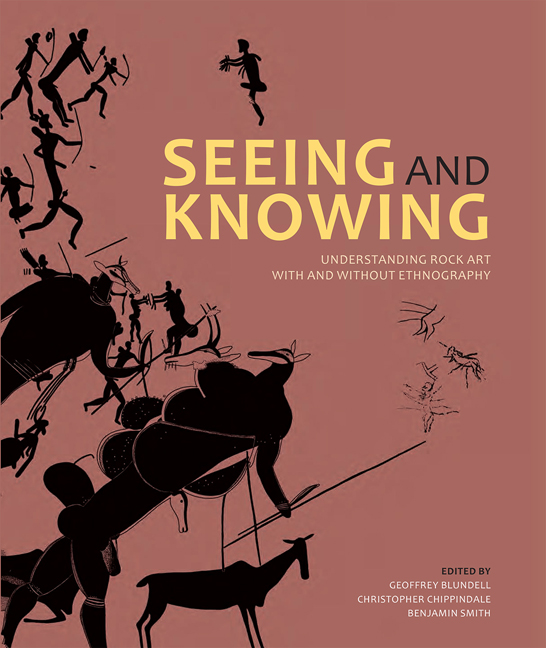Book contents
- Frontmatter
- Dedication
- Contents
- Contributors
- Acronyms
- Chapter 1 Rock art with and without ethnography
- Chapter 2 Flashes of brilliance: San rock paintings of heaven's things
- Chapter 3 Snake and veil: The rock engravings of Driekopseiland, Northern Cape South Africa
- Chapter 4 Cups and saucers: A preliminary investigation of the rock carvings of Tsodilo Hills, northern Botswana
- Chapter 5 Art and authorship in southern African rock art: Examining the Limpopo-Shashe Confluence Area
- Chapter 6 Archaeology, ethnography, and rock art: A modern-day study from Tanzania
- Chapter 7 Art and belief: The ever-changing and the never-changing in the Far west
- Chapter 8 Crow Indian elk love-medicine and rock art in Montana and Wyoming
- Chapter 9 Layer by layer: Precision and accuracy in rock art recording and dating
- Chapter 10 From the tyranny of the figures to the interrelationship between myths, rock art and their surfaces
- Chapter 11 Composite creatures in European Palaeolithic art
- Chapter 12 Thinking strings: On theory, shifts and conceptual issues in the study of Palaeolithic art
- Chapter 13 Rock art without ethnography? A history of attitude to rock art and landscape at Frøysjøen, western norway
- Chapter 14 ‘Meaning cannot rest or stay the same’
- Chapter 15 Manica rock art in contemporary society
- Chapter 16 Oral tradition, ethnography, and the practice of north American archaeology
- Chapter 17 Beyond rock art: Archaeological interpretation and the shamanic frame
- List of figures
- List of tables
- List of publications by david Lewis-williams
- Index
Chapter 10 - From the tyranny of the figures to the interrelationship between myths, rock art and their surfaces
Published online by Cambridge University Press: 21 April 2018
- Frontmatter
- Dedication
- Contents
- Contributors
- Acronyms
- Chapter 1 Rock art with and without ethnography
- Chapter 2 Flashes of brilliance: San rock paintings of heaven's things
- Chapter 3 Snake and veil: The rock engravings of Driekopseiland, Northern Cape South Africa
- Chapter 4 Cups and saucers: A preliminary investigation of the rock carvings of Tsodilo Hills, northern Botswana
- Chapter 5 Art and authorship in southern African rock art: Examining the Limpopo-Shashe Confluence Area
- Chapter 6 Archaeology, ethnography, and rock art: A modern-day study from Tanzania
- Chapter 7 Art and belief: The ever-changing and the never-changing in the Far west
- Chapter 8 Crow Indian elk love-medicine and rock art in Montana and Wyoming
- Chapter 9 Layer by layer: Precision and accuracy in rock art recording and dating
- Chapter 10 From the tyranny of the figures to the interrelationship between myths, rock art and their surfaces
- Chapter 11 Composite creatures in European Palaeolithic art
- Chapter 12 Thinking strings: On theory, shifts and conceptual issues in the study of Palaeolithic art
- Chapter 13 Rock art without ethnography? A history of attitude to rock art and landscape at Frøysjøen, western norway
- Chapter 14 ‘Meaning cannot rest or stay the same’
- Chapter 15 Manica rock art in contemporary society
- Chapter 16 Oral tradition, ethnography, and the practice of north American archaeology
- Chapter 17 Beyond rock art: Archaeological interpretation and the shamanic frame
- List of figures
- List of tables
- List of publications by david Lewis-williams
- Index
Summary
Rock art was often deliberately made where communication with the spirits was believed to be good. It was therefore made in caves and shelters, on steep cliffs, high in the mountains and on the shore – a range of localities all considered transitional spaces between cosmic worlds (Lewis-Williams & Dowson 1990; Tilley 1991; Whitley 1998; Helskog 1999). This emphasises that rock art is often just one part of a broader ritual landscape. This chapter focuses on the physical rock art panel, the surface with art, and how this art engages with the rock art figures. On some surfaces, specific topographic features enhanced the form of the figures. Figures directly associated with cracks and fissures appear to be climbing out from inside/under the surface, or a serpent depicted in a basin is interpreted as a serpent within water, or the tracks of the bear entering a basin are interpreted as the bear going underwater, passing through to the underworld (Helskog 1999). To secure a prosperous field season at Besov Nos on the east coast of Lake Onega in Karelia, some Russian archaeologists always start fieldwork by sacrificing a shot or two of vodka into the mouth – a fissure – of the large rock engraving called ‘the demon’. Fieldwork is always good.
Topographic features might be one reason for selecting a particular surface; orientation to the sun, dark hidden places, colours and the presence of water are others. It is to be expected that around the world the reasons will be numerous, the locations different – each particular to a specific culture and to that people's rituals and understandings of their life in the known universe. However, in many areas it is clear that surfaces were selected with great care, for specific reasons, all connected with the symbolism of the rock art. These points are demonstrated for a series of rock art panels made by prehistoric hunter-fisher-gatherers in Alta, Arctic Norway (Figure 10.1).
THE TYRANNY
During the last few years, my understanding of rock art has changed. The process began when I saw compositions in which bears were the central ‘actors’ (Figure 10.2). These seemed to be illustrations in which the animals moved through space and time. This was a story in which I could recognise some key elements without needing to know the full meaning (Helskog 1999).
- Type
- Chapter
- Information
- Seeing and KnowingUnderstanding Rock Art With and Without Ethnography, pp. 168 - 187Publisher: Wits University PressPrint publication year: 2010



